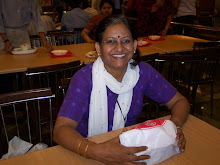Equity issues continue to confront the realities of the not-so-fortunate citizens of India. It is with this reality that I try to reflect on Smart Village programme of Andhra Pradesh or Smart Cities of Urban Development Ministry of Government of India or the very amibitious Digital India programme, that sums up a technology led and driven future.
What is important is to understand that the poor still struggle with existential issues and are dealing with inequities of undefinable proportions. Where are the foot paths for those who don't have means to a transport vehicle or have to either cycle on walk on the now fast developing free-way or high-way stretches? How do small shops that are on the side of these highways make a living if there are no plans or ways of allowing the way-farers to stop and pick up something? How many such small enterprises and businesses have gone kaput?
With many definitions of poverty and poverty line definitions and Aadhaar card based service delivery becoming an absolute reality, there are still several poor people who are out of this net. It is because either they are Banjaras (nomads who have no proof of residence) or are outcastes (still a reality in many communities) or have never really relied on government dole as they are forest dwellers or tucked away scheduled tribe, who still do not speak the mainstream language)... these and others should count. But, do they? Really?
Those spending over Rs 32 a day in rural areas and Rs 47 in towns and cities should not be considered poor, an expert panel headed by former RBI governor C Rangarajan said in a report submitted to the BJP government way back in July 2014. The debate continues.
Take for example, when my press wala recently hiked the rate of ironing each piece of material from Rs five to Rs six, several of us made a small protest.
Anna, who is running 74 and who has been ironing outside Pearl Apartments in Begumpet area for the last 49 years says that is becoming increasingly difficult for him to make ends meet. He says, coal prices have increased, and it is impossible for him to even buy a new saree for his wife once a year! He says the daily needs are sold at the same price for you and me.. so how do you expect me to live in this city without increasing the price? At Rs 47 per day calculation, Anna is definitely not poor. And he no longer will be able to avail any dole, since he is landless, has no house (still lives on rent, pays Rs 2000 a month for his shanty room, without a bathroom, kitchen or toilet). But he has managed to educate his two boys upto Class X and XII respectively. Yet, he is hopeful that things will change for the better for his two sons.
Based on the Suresh Tendulkar panel's recommendations in 2011-12, the poverty line had been fixed at Rs 27 in rural areas and Rs 33 in urban areas, levels at which getting two meals may be difficult. If this was the case, he will not be able to pay even the rent for his shanty.
It is a pity that learned people who live in urban rich areas or around government flats and rely on people such as Anna are so blinded by the realities that surrounds them. When will we wake up to the needs of the poor but proud people like Anna and make Digital India a reality for them? Will they be able to have a better means of livelihoods, an enterprise that is not dependent on the scam ridden coal? Will they get small quantities of coal that they need at reasonable rates?
Time will tell if equity principles are enshrined in the vision and implementation modalities of Digital India, as they take shape in the coming months.



